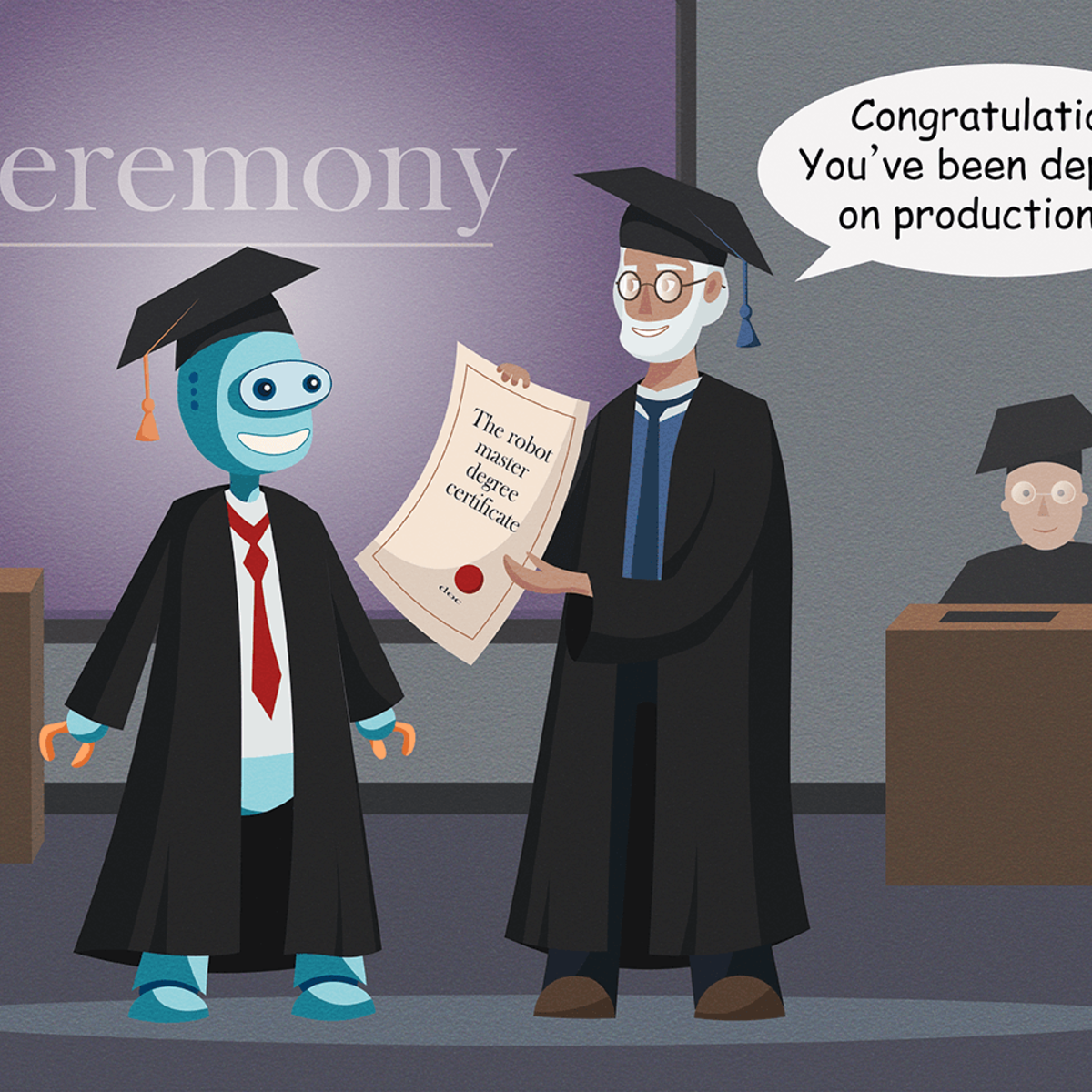Back to Courses









Computer Science Courses - Page 40
Showing results 391-400 of 2309

Add Ragdoll Effect to a Character in Unity
Unity Physics is a great mechanic that simulates real-life physics into a character within a Scene. One entertaining effect in some games is the "ragdoll" effect, usually activated when a player or NPC dies or is thrown into the air. Traditionally, it is a complicated matter to set up a ragdoll, but Unity has created a Ragdoll Wizard that makes the process quite straightforward.
In this one-hour, project-based course, you will create a ragdoll pirate that flops in a heap, to the delight of the players of your game! You'll learn about the basics of Unity's Ragdoll Wizard, including configuring colliders, joints and physic materials for a more-realistic Ragdoll effect. You'll also learn the C# code required to toggle the effect with a key-press.
The guided project will introduce you to the following Unity concepts:
-Ragdoll Wizard
-Physics Debugger
-Collider
-Character Joint
-Physic Material
-Basic C#

Four Rare Machine Learning Skills All Data Scientists Need
This course covers the most neglected yet critical skills in machine learning, four vital techniques that are very rarely covered – most courses and books omit them entirely.
1) UPLIFT MODELING (AKA PERSUASION MODELING): When you're modeling, are you even predicting the right thing?
2) THE ACCURACY FALLACY: When evaluating how well a model works, are you even reporting on the right thing?
3) P-HACKING: Are your simplest discoveries from data even real?
4) THE PARADOX OF ENSEMBLE MODELS: Do you understand how they work, even though they seem to defy Occam's Razor?
>> WHY THESE ADVANCED METHODS ARE ESSENTIAL: Each one addresses a question that is fundamental to machine learning (above). For many projects, success hinges on these particular skills.
>> NO HANDS-ON – BUT FOR TECHNICAL LEARNERS: This course has no coding and no use of machine learning software. Instead, it lays the conceptual groundwork before you take on the hands-on practice. When it comes to these state-of-the-art techniques and prevalent pitfalls, there's a foundation of conceptual knowledge to build before going hands-on – and you'll be glad you did.
>> VENDOR-NEUTRAL: This course includes illuminating software demos of machine learning in action using SAS products. However, the curriculum is vendor-neutral and universally-applicable. The contents and learning objectives apply, regardless of which machine learning software tools you end up choosing to work with.

Intermediate PostgreSQL
This course covers a wide range of SQL techniques, beyond basic CRUD (Create, Read, Update, and Delete) operations in PostgreSQL. You will learn the specifics of aggregation, transactions, reading and parsing CSV files and inserting data into a database. You’ll also take a look at how PostgreSQL handles and indexes text data.
Specifically, students will do assignments that alter table schemas, create stored procedures, construct advanced queries, explore sorting and grouping query data, and techniques for working with text in databases including regular expressions.

Optimize Digital Experiences with Service Blueprints in Miro
By the end of this project, you will be able to create a service blueprint that emphasizes digital experiences the customer has with a brand in Miro. Your project will uncover business opportunities by methodically mapping service touchpoints to mitigate risk to improve the customer experience.
To optimize digital experiences with a service blueprint visualization, you will gain hands-on experience applying design thinking, user interface knowledge, and context from each step of the customer experience with the service in the Miro online visual collaboration platform for teamwork.
Note: This course works best for learners who are based in the North America region. We’re currently working on providing the same experience in other regions.

Developing FPGA-accelerated cloud applications with SDAccel: Practice
This course is for anyone passionate about learning how to develop FPGA-accelerated applications with SDAccel!
The more general purpose you are, the more flexible you are and the more kinds of programs and algorithms you can execute on your underlying computing infrastructure. All of this is terrific, but there is no free food and this is happening, quite often, by losing in efficiency.
This course will present several scenarios where the workloads require more performance than can be obtained even by using the fastest CPUs. This scenario is turning cloud and data center architectures toward accelerated computing. Within this course, we are going to show you how to gain benefits by using Xilinx SDAccel to program Amazon EC2 F1 instances. We are going to do this through a working example of an algorithm used in computational biology.
The huge amount of data the algorithms need to process and their complexity raised the problem of increasing the amount of computational power needed to perform the computation. In this scenario, hardware accelerators revealed to be effective in achieving a speed-up in the computation while, at the same time, saving power consumption. Among the algorithms used in computational biology, the Smith-Waterman algorithm is a dynamic programming algorithm, guaranteed to find the optimal local alignment between two strings that could be nucleotides or proteins. In the following classes, we present an analysis and successive FPGA-based hardware acceleration of the Smith-Waterman algorithm used to perform pairwise alignment of DNA sequences.
Within this context, this course is focusing on distributed, heterogeneous cloud infrastructures, providing you details on how to use Xilinx SDAccel, through working examples, to bring your solutions to life by using the Amazon EC2 F1 instances.

Deploy Models with TensorFlow Serving and Flask
In this 2-hour long project-based course, you will learn how to deploy TensorFlow models using TensorFlow Serving and Docker, and you will create a simple web application with Flask which will serve as an interface to get predictions from the served TensorFlow model.
This course runs on Coursera's hands-on project platform called Rhyme. On Rhyme, you do projects in a hands-on manner in your browser. You will get instant access to pre-configured cloud desktops containing all of the software and data you need for the project. Everything is already set up directly in your Internet browser so you can just focus on learning. For this project, you’ll get instant access to a cloud desktop with (e.g. Python, Jupyter, and Tensorflow) pre-installed.
Prerequisites:
In order to be successful in this project, you should be familiar with Python, TensorFlow, Flask, and HTML.
Notes:
- You will be able to access the cloud desktop 5 times. However, you will be able to access instructions videos as many times as you want.
- This course works best for learners who are based in the North America region. We’re currently working on providing the same experience in other regions.

Create Your UI/UX Portfolio with GitHub
Learners will create a portfolio showcasing their UI/UX projects and deploy it to GitHub. Creating a strong portfolio showcases not only their skills as a designer, but also their perseverance to learn some new skills outside the typical purview of a designer (in this case, coding languages HTML and CSS, and Microsoft’s Visual Studio Code).

Python Basic Structures: Lists, Strings, and Files
Code and run your first python program in minutes without installing anything!
This course is designed for learners with limited coding experience, providing a solid foundation of not just python, but core Computer Science topics that can be transferred to other languages. The modules in this course cover lists, strings, and files. Completion of Python Basics: Selection and Iteration before taking this course is recommended.
To allow for a truly hands-on, self-paced learning experience, this course is video-free. Assignments contain short explanations with images and runnable code examples with suggested edits to explore code examples further, building a deeper understanding by doing. You'll benefit from instant feedback from a variety of assessment items along the way, gently progressing from quick understanding checks (multiple choice, fill in the blank, and un-scrambling code blocks) to small, approachable coding exercises that take minutes instead of hours.

Dart: Variables, Data Structures, Objects, and Conditionals
This is a self-paced lab that takes place in the Google Cloud console.
In this lab you will learn more about the basics of Dart. Build on your knowledge of Dart development

Typescript in React: useContext, useReducer, Type assertion
By the end of this course you will be able to incorporate state management with useContext and useReducer in a Typescript React application. We will start by revisiting React concepts of useReducer and useContext so we can better focus on the Typescript concepts and behaviours.
This course is aimed at developers who are familiar with Typescript and understand the basics and would like to have some more experience, especially using some of the more advanced state management patterns in React. We will recap the React concepts We simplify these concepts and then use repetition to actually use these types in real React components.
